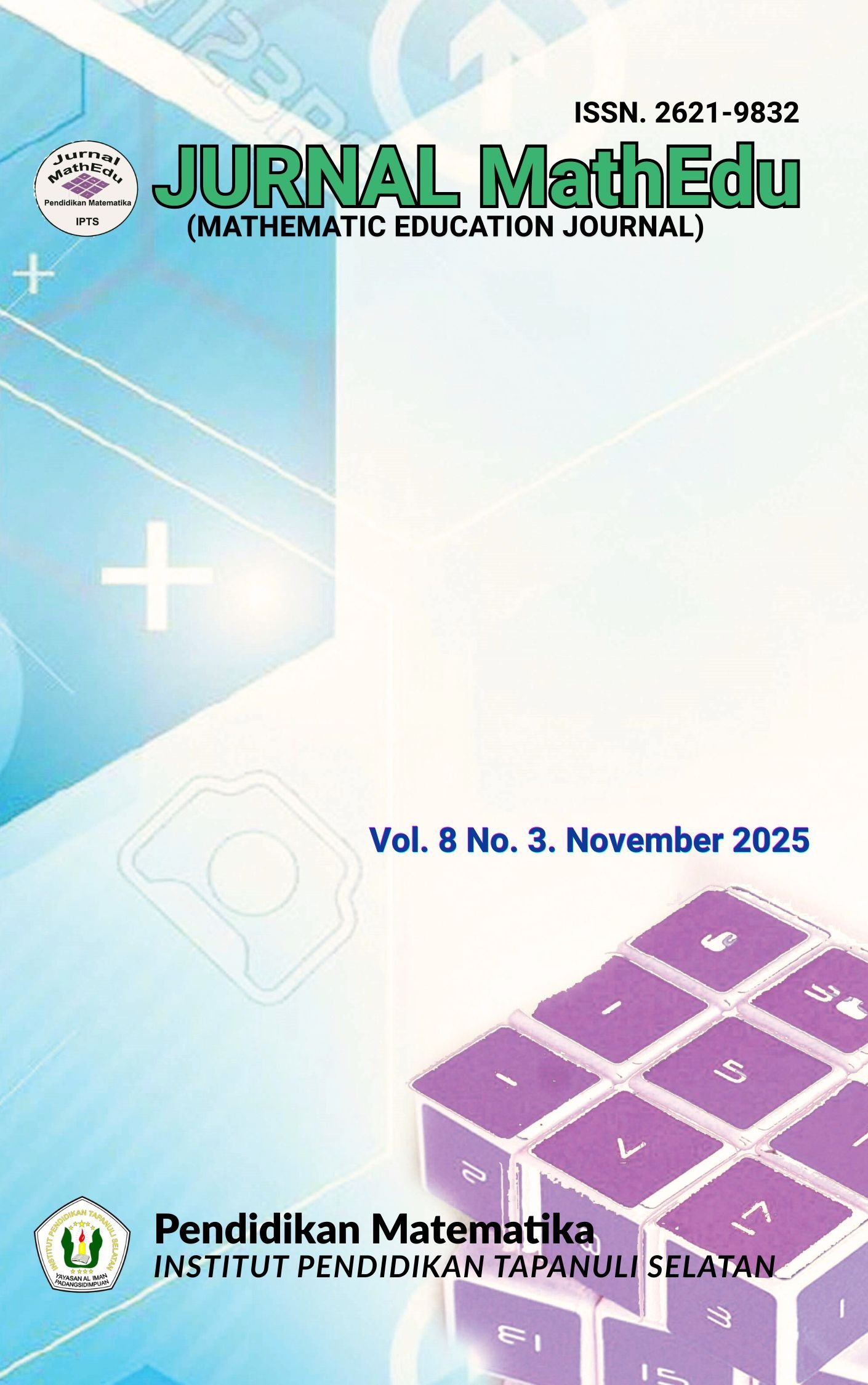STUDI ETNOGRAFI TENTANG STRATEGI SISWA DALAM MENYELESAIKAN SOAL CERITA MATEMATIKA
Main Article Content
Abstract
This study aims to explore the strategies of fourth grade elementary school students in solving math story problems and their inhibiting factors. The approach used was qualitative with ethnographic methods, conducted at SD 3 Wergu Wetan, Kudus. Participants consisted of fourth grade teachers and 10 students who were selected purposively. Data were collected through in-depth interviews, participant observation in the classroom, and document analysis in the form of student work. Data analysis used the Miles and Huberman model: data reduction, data presentation, and conclusion drawing. Data validity was maintained through triangulation of interviews, observations, and documentation. The results showed that students used strategies such as repeated reading, identifying information, drawing, and working with friends. Barriers found included low reading ability, lack of understanding of basic mathematical concepts, as well as the post-pandemic impact on learning behavior. Teachers observed students' difficulties in understanding the problems and realized the importance of improving reading skills and math concepts. Teachers' efforts include reinforcement of basic math, repetition of material, interesting approaches, and peer tutors. This study emphasizes the importance of reading skills, mastery of basic mathematics concepts, and adaptive learning strategies to improve students' ability in mathematics story problems.
Article Details
Authors who publish with this journal retain copyright to their articles. However, they grant the journal the right of first publication with the work simultaneously licensed under a Creative Commons Attribution License that allows others to share the work with an acknowledgment of the work's authorship and initial publication in this journal.
References
Astarini, M. H. (2023). Penerapan Scaffolding sebagai Upaya Meningkatkan Hasil Belajar Matematika Siswa Kelas VIII pada Materi Lingkaran. Ideguru: Jurnal Karya Ilmiah Guru, 8(3), 646–652. https://doi.org/10.51169/ideguru.v8i3.620
Daffa Tasya Pratiwi, & Fitri Alyani. (2022). Kemampuan Pemecahan Masalah Matematika Siswa Kelas V SD Pada Materi Pecahan. Journal for Lesson and Learning Studies, 5(1), 136–142. https://doi.org/10.23887/jlls.v5i1.49100
Dwi Maharani, I., Ermawati, D., Riswari, L. A., & Dwi, I. (2024). Analisis Penyebab Kesalahan yang Biasa Terjadi dalam Menyelesaikan Soal Cerita Bilangan Bulat. EDUKASIA: Jurnal Pendidikan Dan Pembelajaran, 5, 483–494. http://jurnaledukasia.org
Dwi Putra, E. (2021). STRUKTUR BERPIKIR SISWA PADA ZONE OF PROXIMAL DEVELOPMENT DALAM PEMBELAJARAN DISCOVERY LEARNING. 7(2), 71–79.
Ermawati, D., Riswari, L. A., Shoufika Hilyana, F., & Wijayanti, E. (2024). PENGEMBANGAN BUKU CERITA MATEMATIS BERBASIS AUGMENTED REALITY UNTUK KEMAMPUAN BERNALAR KRITIS SISWA SD. 7(2). https://doi.org/10.31539/judika.v7i2.12454
Fara Fatika Maharani, Putri Jenar Mahesa Ayu, Nur Kusuma Astuti, & Diana Ermawati. (2024). Analisis Kemampuan Pemecahan Masalah Matematis Pada Materi Penjumlahan Dan Pengurangan di Kelas II SDN 1 Selojari. Bilangan : Jurnal Ilmiah Matematika, Kebumian Dan Angkasa, 2(4), 205–216. https://doi.org/10.62383/bilangan.v2i4.182
Fatchiyah S, R., Rondli, W. S., & Ermawati, D. (2024). Penerapan Student Teams Achievement Division untuk Meningkatkan Hasil Belajar Siswa Sekolah Dasar. Jurnal Pendidikan Dan Pembelajaran Indonesia (JPPI), 4(3), 1197–1206. https://doi.org/10.53299/jppi.v4i3.701
Hasil Belajar Siswa Pada Mata Pelajaran Pendidikan Agama Islam Man, P. DI, & Rony Zulfirman, M. (n.d.). IMPLEMETASI METODE OUTDOOR LEARNING DALAM. Pendidikan Dan Pengajaran |, 3, 2022. http://dx.doi.org/10.30596%2Fjppp.v3i2.11758
Khaq, S. A., Hilyana, F. S., & Ermawati, D. (2025). PENERAPAN PENDEKATAN PMRI BERBASIS KONTEKSTUAL TERHADAP KEMAMPUAN BERPIKIR KRITIS SISWA KELAS IV SD. SIGMA: JURNAL PENDIDIKAN MATEMATIKA, 16(2), 258–268. https://doi.org/10.26618/sigma.v16i2.15230
Kemampuan, P., Masalah, P., & Anak, M. (2022). Jurnal jendela pendidikan, 2(04), 621–626.
Naja, F. Y., & Sao, S. (2024). Peningkatan Berpikir Matematis Siswa Sekolah Dasar Melalui Implementasi Model Problem Based Learning. Jurnal Cendekia : Jurnal Pendidikan Matematika, 8(2), 1049–1059. https://doi.org/10.31004/cendekia.v8i2.3124
Najwa, W. A. (2020). Kemampuan Representasi Piktorial Operasi Hitung Pecahan pada Mahasiswa Pendidikan Guru Sekolah Dasar. Jurnal Pemikiran Dan Pengembangan Sekolah Dasar), 8(1). https://doi.org/10.22219/jp2sd
Ode Sarfia Ode Rahimu, W. (2021). Efektivitas Penggunaan Media Pembelajaran Visual pada Mata Pelajaran Matematika Terhadap Prestasi Belajar Siswa. Jurnal Akademik Pendidikan Matematika, 7(1), 50. https://www.ejournal.lppmunidayan.ac.id/index.php/matematika
pengertian observasi. (n.d.).
pengertian observasi (2). (n.d.).
Ramadhan, I., Manisah, A., Angraini, D. A., Maulida, D., Sana, S., & Hafiza, N. (2022). Proses Perubahan Pembelajaran Siswa dari Daring ke Luring pada Saat Pandemi Covid-19 di Madrasah Tsanawiyah. EDUKATIF : JURNAL ILMU PENDIDIKAN, 4(2), 1783–1792. https://doi.org/10.31004/edukatif.v4i2.2200
Rohmah, F. N., Ermawati, D., & Hilyana, F. S. (2024). PENERAPAN MODEL SUPERITEM DALAM MENINGKATKAN KEMAMPUAN PEMAHAMAN KONSEP MATEMATIS SISWA SD. Jurnal Ilmiah Pendidikan Citra Bakti, 11(4), 1002–1013. https://doi.org/10.38048/jipcb.v11i4.3801
Safitri, A., & Lestari, K. E. (2022). Analisis Kelancaran Prosedural Matematis Siswa Berdasarkan Kemandirian Belajar. Jurnal Educatio FKIP UNMA, 8(2), 444–452. https://doi.org/10.31949/educatio.v8i2.1979
teknik purposive smapling. (n.d.).

